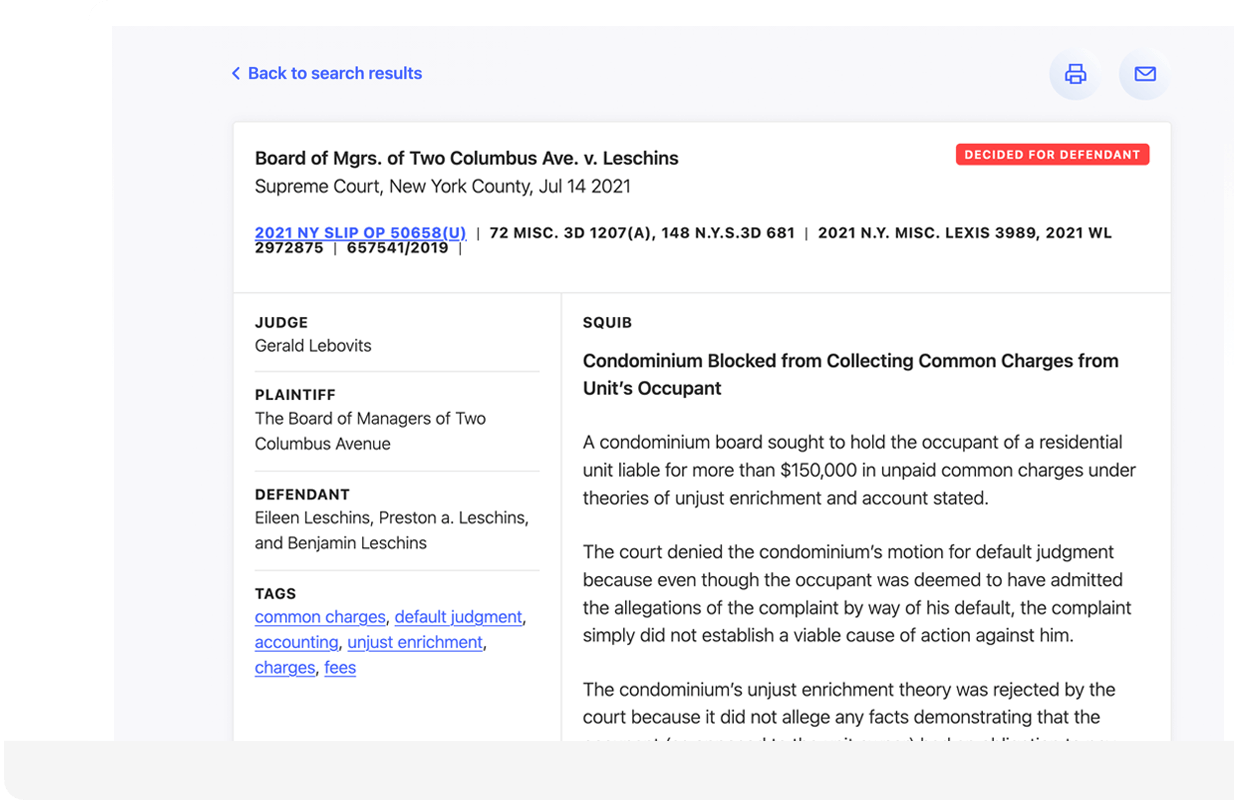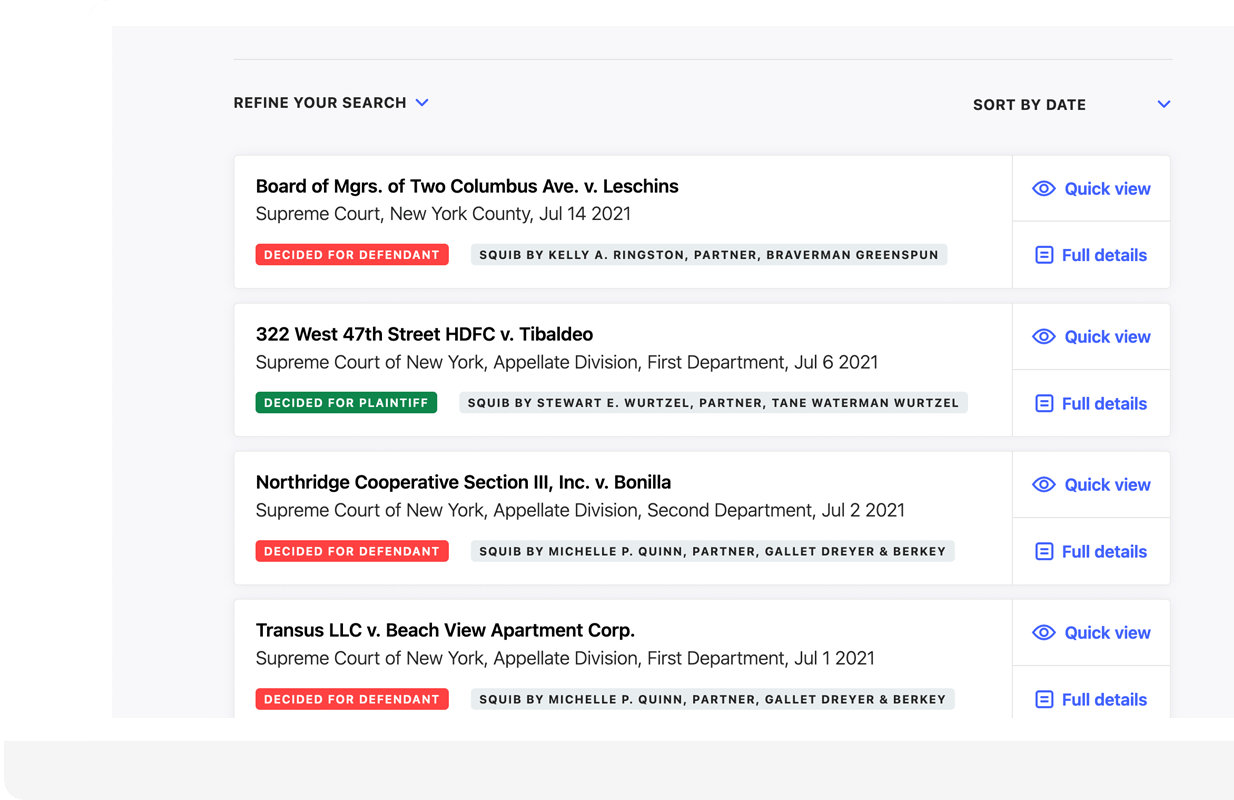Legal Decisions…Simplified and Specific.
A distinguished panel of New York co-op/condo attorneys analyze recent NY co-op/condo decisions. Subscribers receive a monthly PDF Digest of these case summaries and takeaways, an Advance Sheet of co-op/condo court cases recently decided, and access to the searchable Tracker database.
Take a Test Drive for $130-Day Test Drive. Cancel Anytime.
The Specifics of Search Success…
Addressing the specific and unique needs of today’s niche community of New York's co-op and condo professionals, Case Law Tracker does the heavy lifting—combing through and drawing out the cases most relevant to your needs.
Case Summaries
Focusing only on co-op and condo cases, practicing attorneys in this field prepare case summaries and useful takeaways - helping you understand what the case is about so you can quickly determine if it benefits you.
Case View
Our Quick View feature enables you to instantly determine if the case is relevant to your needs and provides you with a fast click to the full details of the case including judges, case history, as well as an active slip op link to related court documents.
Monthly Digest & Monthly Advance Sheet
A pdf Digest of all co-op/condo cases added to the database is emailed monthly to you. Plus, to keep you up to date on what the courts have most recently decided, you'll receive, monthly, an Advance Sheet with case names, decision and docket links, judges, and brief decision excerpts.
Searchable Database
Speeding you to exactly what you need, our robust search offers: a simple quick search; dropdown menus to refine that search; and powerful filtering capability that lets you drill down even further by court, judge, residence, tag, and date.
Advisory Panel
Our experienced advisory committee, comprised of industry-specific experts who truly understand the issues that matter to you, write the case summaries. They know what you need to know and help you get to that information as quickly and easily as possible.
Case Watch
Emailed twice-monthly, Case Watch focus on providing insight on one particularly relevant case—clearly explaining what happened, why it’s important, and what lessons can be learned within. Case Watch reaches two audiences: lawyers who subscribe to the Co-op & Condo Case Law Tracker and Habitat Magazine subscribers (co-op and condo board directors, property managers and other industry professionals).
Case Notes See all
Case Notes provides insight on one particularly relevant co-op or condo case—clearly explaining what happened, why it’s important, and what lessons can be learned within.
First published: Jun 2025
$9M on Ice While Flatiron Condo Fight Heats UpTAKEAWAY Even before a hotly contested litigation is fully adjudicated, a court may effectively punish a defaulting sponsor by depriving it, for an extended time period, of substantial profits from a sale of one or more of its units. When an inequity or impropriety is suspected, it will also step in and protect a Board of Managers against an allegedly unscrupulous sponsor. To assure a positive result, counsel for a Board of Managers should carefully review the offering plan and relevant documents, and present cogent evidence of a sponsor’s wrongdoing before a trial is scheduled so that the court can direct appropriate, albeit punitive, relief. While a $500,000 undertaking may also seem daunting, it is a small price to pay compared to the risk that sponsors' assets will be prematurely transferred, and/or inaccessible to the condo, making any victory meaningless.
Read full articleFirst published: Jun 2025
Bin Battle at 521 Park AvenueTAKEAWAY A storage bin (unless included in the definition of the unit) in a condominium is typically a common element. As such the unit owner using it has no proprietary right to it, and is granted the use of it only until the board takes it back. Rather than take a chance as to what a court might do, it is wise for any condominium board that allows a unit owner to use any common element to demand that a license agreement be signed by the unit owner. That document would set forth the rights and obligations of both parties. By doing so, the condominium can make it clear that it would have the right to terminate the use of the common element at any time. It should be noted that if a bin (or other property outside of the unit) is designated as a limited common element, the declaration and bylaws should be carefully reviewed as to the rights of the unit owner to use the property.
Read full articleFirst published: May 2025
It Snowballed with “Snowball”TAKEAWAY The story took a significant turn when an appellate court stepped in and ruled that the co-op couldn't simply kick Zelmanovich out of her apartment without first allowing the court to properly examine the facts. The higher court said that before any eviction could proceed, there needed to be a real determination about two key questions: Was Snowball's barking actually as disruptive as the co-op claimed? And did the co-op illegally discriminate against Zelmanovich? This case highlights an important issue that co-op boards should consider: Is it appropriate to try to evict a longtime resident when, as appears to be the situation here, all the complaints are coming from just one neighbor? There's another troubling aspect to this story. When Zelmanovich told the co-op that Snowball was her emotional support animal — meaning she needed the dog as a reasonable accommodation animal — the co-op and Zelmanovich should have communicated in an attempt to come to some kind of compromise or accommodation. Instead, it seems like both sides dug in their heels without really trying to solve the problem. Now, four years after this whole ordeal began - what started as a simple complaint about a barking dog — the legal battle shows no signs of ending. A case that might have been resolved through communication and goodwill has instead turned into a prolonged court fight that continues to drag on.
Read full article



